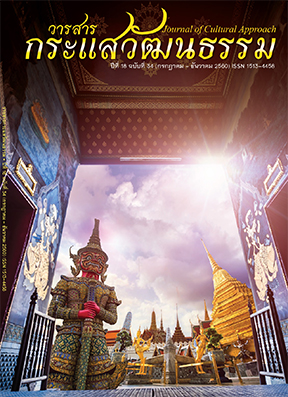Thai Popular Music Guru Mongkol Amatyakul: Characteristic, Knowledge, Wit and Successful Creator of the Music Band and Outstanding Singers
Main Article Content
Abstract
This thesis aimed to study biography and work pieces of Thai popular music master, Mr. Mongkol Amatyakul regarding his band instructing and practices which brought a great deal of success to his artists, as well as his achievement in establishing successful singers and musical works to the public. The study employed qualitative design to study his 6 awarded songs: 1) Yoei Fa Tah Din, 2) Chang Rai Luah 3) Kwam Lang Fang Chai, 4) Tua Klai Chai Yang, 5) Yak Ja Bok Rak Tae Mai Klah (Nai Duang Chai), and 6) Nok Kow Chan Kown.
The study of his biography and his works revealed that Mr. Mongol Amatyakul was born on February 9th, 1918 in Pra Nakhon District, Bangkok. He accomplished his graduation in elementary (Pratom) level and early secondary level (Mattayom 1) from Wat Chanasongkram School, Mattayom 3-4 from Horwang School, and Mattayom 5-6 from Prathumkongka Scool. Later, he continued his study in pre-university level or Mattayom 8 in Suan Kularb Wittayalai School and went to Faculty of Veterinary in Chulalongkorn University. During his 4th year of university, World War II began which compelled the university to announce an academic break. Therefore, he started to participate more in his music path. He formed a band named “Chularat” and his music was performed by the renowned artists namely Mr. Pong Preeda, Mr. Nakhon Tanomsab, Mr. Toon Tongjai and Mr. Pon Pirom. These 4 artists were known as “The Four Musketeers” of Chularat Band. Besides his work with the band, he contributed success to several Thai artists. Chularat Band had been performing ever since until 1973. The band broke up due to his physical condition. He was given medical treatment all along. At last, he passed away at 72 during the way to the hospital. Royal cremation ceremony was granted to him on January 3rd, 1990 at Makut Kasat Karam Temple.
The 6 chosen songs composed by Mr. Mongol Amatyakul were written in AABA and ABCD structures, mainly in 3/4 and 4/4 time with various syncopation patterns in each song. In addition, the songs employed sequential movement rather than leap movement with the scale range from Perfect 11th to Perfect 12th. Most songs were written in pentatonic scale and the lyrics were mostly rhymed at down beat notes more than upbeat notes.
Article Details
Proposed Creative Commons Copyright Notices
1. Proposed Policy for Journals That Offer Open Access
Authors who publish with this journal agree to the following terms:
- Authors retain copyright and grant the journal right of first publication with the work simultaneously licensed under a Creative Commons Attribution License that allows others to share the work with an acknowledgement of the work's authorship and initial publication in this journal.
- Authors are able to enter into separate, additional contractual arrangements for the non-exclusive distribution of the journal's published version of the work (e.g., post it to an institutional repository or publish it in a book), with an acknowledgement of its initial publication in this journal.
- Authors are permitted and encouraged to post their work online (e.g., in institutional repositories or on their website) prior to and during the submission process, as it can lead to productive exchanges, as well as earlier and greater citation of published work (See The Effect of Open Access).
Proposed Policy for Journals That Offer Delayed Open Access
Authors who publish with this journal agree to the following terms:
- Authors retain copyright and grant the journal right of first publication, with the work [SPECIFY PERIOD OF TIME] after publication simultaneously licensed under a Creative Commons Attribution License that allows others to share the work with an acknowledgement of the work's authorship and initial publication in this journal.
- Authors are able to enter into separate, additional contractual arrangements for the non-exclusive distribution of the journal's published version of the work (e.g., post it to an institutional repository or publish it in a book), with an acknowledgement of its initial publication in this journal.
- Authors are permitted and encouraged to post their work online (e.g., in institutional repositories or on their website) prior to and during the submission process, as it can lead to productive exchanges, as well as earlier and greater citation of published work (See The Effect of Open Access).
References
[2] Artist of Music. (1999). Celebrations on the Auspicious Occasion of His Majesty the King’s 6th Cycle Birthday Anniversary, 5 December 1999. Bangkok: The Government Public Relations Department.
[3] Bangkok Bank. (n.d.). Legend of Thai Television with Jumnong Rangsikul. Bangkok: Bangkok Bank Public Company Limited.
[4] Chularat Band. (n.d.). In Wikipedia. Retrieved from https://th.wikipedia.org/wiki/Chularat. (in Thai)
[5] College of Music, Mahidol University. (1995). Musical Guide 3. Bangkok: Samakkhisan (Dokya) Public Company Limited.
[6] Conferences and Seminars (1990). Way of Thai Contemporary Music. Bangkok: Department of Cultural Promotion.
[7] Dansakul, Nopporn. (2004). Analyzed of Literature Music and Folk Songs in Thailand Performed by Pongsri Woranut. Songkhla: Faculty of Fine Arts, Thaksin University.
[8] Dansakul, Nopporn. (2012). History of Thai Music. Bangkok: Charansanitwong Printing Company Limited.
[9] Department of Cultural Promotion. (n.d.). Thailand-Century Folk Song. Ministry of Culture: Department of Cultural Promotion.
[10] Fine Arts Department. (1984). From Thai Music to Thai Contemporary Music. Bangkok Bank Public Company Limited.
[11] Pidokrajt, Narongchai. (2012). Ethnomusicology. Musicology College of Music, Mahidol University.
[12] Pommitavon, Krittavit. (2016). Works in Thai Popular Music Composed By Mr. Mongol Amatyakul: His Manner, Knowledge and Promotion Carriers to Establish the Successful Music Band and Outstanding Singers. Master’s Thesis. Mahidol University.
[13] Royal Institute Dictionary. (2005). International Music. Bangkok: Office of the Royal Society.
[14] Rungreuang, Pratya. (1973). Foundation of Ethnomusicology. Bangkok: Kasetsart University.
[15] Sokatiyanurak, Natcha. (2004). Analyzed and Composer in Classic Music. Bangkok: Chulalongkorn University.
[16] Sokatiyanurak, Natcha. (2009). Support of the Arts Orchestra Terminology. Bangkok: Chulalongkorn University.
[17] Thongkrop, Siriporn. (2004). Evolution Music in Thailand. Bangkok: Panthakit Publishing Company Limited.


